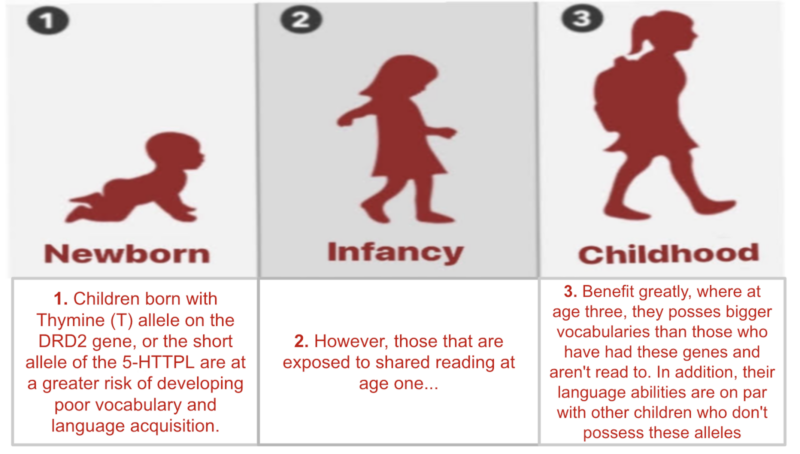Written by Munisa Said (PSY, 2022) & Crystal Lee (PSY, G2)
Why is it so important for parents to read to their children? Previous research has found that when parents read to their infants (also called “shared reading”), there are significant improvements in early language development (Mol & Bus, 2011). However, not all children broadly benefit from shared reading. The advantages of shared reading vary quite widely among children. A recent paper led by researchers from Princeton and Rutgers Universities endeavored to explain this variability by considering genetic factors that may impact this development of language acquisition. In previous studies, individual differences in dopaminergic and serotonergic systems (the neural pathways that deliver dopamine and serotonin throughout the brain) have been implicated in different outcomes for learning, attention, and behavior. Thus, Jiminez et al. examined the genetic characteristics of these systems of almost 2,000 children in order to see if this variable also explained the diverse effects of shared reading.
Jimenez and colleagues conducted their study using data from the Fragile Families and Child Wellbeing Study. This study collected data from nearly 5,000 children, the majority of whom had mothers who were unmarried and all of whom were born into urban communities. See here for a more detailed explanation of the research methodology used to collect the Fragile Families dataset as well as our previous article reviewing the predictability of life comes using this dataset. Jimenez and colleagues examined data from 1,772 infants for whom data was collected about their shared reading exposure (at one year old), their vocabulary size (at three years old), and their genetic make-up (at 9 years old). The authors’ hypothesized that shared reading exposure should improve children’s vocabulary size, but that the extent of the improvement would depend on each child’s genetic makeup.
In examining the participants’ genetic makeup, this study focused on alleles in gene variants that have been shown to affect the dopaminergic and serotonergic neurotransmitter systems.These alleles are known as “sensitizing” alleles, whose presence is thought to increase the sensitivity to the environment within the children who possess them. Notably, these variants have been shown to lead to phenotypes that would presumably affect the efficiency of shared reading (such as attention deficit and poor cognitive control). The first allele the research team examined was the thymine (T) allele. This allele affects the Taq1A single nucleotide polymorphism of the dopamine receptor 2 gene (DRD2) and has been associated with poor cognitive control. The second was a 7-repeat allele that appears on the dopamine receptor 4 gene (DRD4) and has previously been associated with ADHD. Lastly, they examined a variant of the DAT1 (dopamine transporter) gene which has also been linked to ADHD. In addition, the researchers included examination of a short allele of the serotonin transporter gene, referred to as 5-HTTLPR. This allele has been linked to academic performance and childhood care.
By utilizing linear regression, the authors found that shared reading exposure during the first year of life correlates to a more expansive vocabulary at 3 years old, replicating previous research and confirming the importance of shared reading for language development. Critically, of the sensitizing alleles, Jimenez et al. saw that the presence of the thymine (T) allele on the DRD2 gene and the short allele of the serotonin transporter, 5-HTTLPR, significantly moderated the relationship between shared reading exposure and vocabulary development. Children who possessed this allele showed a greater risk for poor vocabulary. However, daily shared reading significantly improved their vocabulary size, compared to those who were not exposed to shared reading. In comparison, for children who did not possess this allele, differences in exposure to shared reading did not greatly vary vocabulary size. This finding not only demonstrates the heterogeneity of the benefits of shared reading on vocabulary but suggests that there are genetic differences underlying the relationship between shared reading and later vocabulary. These genetic differences between children may explain the heterogeneity in outcomes of vocabulary size when considering shared reading.
Ultimately, this research points to a crucial insight concerning studies of early adversity in child development: research should focus not only on the negative outcomes of early adversity, but also the resilience that can be displayed. Jiminez et al. reveal that the negative language outcomes associated with the presence of these alleles were attenuated when infants were exposed to shared reading. In fact, those who possessed these alleles but were exposed to shared reading made vocabulary gains on par with those who did not possess the same genetic variants. This research makes the critical point that policy insight should create supportive, positive environments for those who might be vulnerable. These modifications, such as supporting initiatives that promote shared reading, may help a vulnerable population do as well as their peers.
Dr. Jiminez explained that he and his team at Rutgers University are conducting “additional work to identify optimal strategies for literacy promotion in primary care where pediatricians encourage activities like shared reading to help address persistent inequities in developmental and behavioral health”. Likewise, Dr. Notterman and his lab at Princeton are continuing to “explore many of the ways the gene-environment interactions shape the development of children.”
The original article was published in The Journal of Pediatrics in January 2020. Please follow this link to view the full version.

